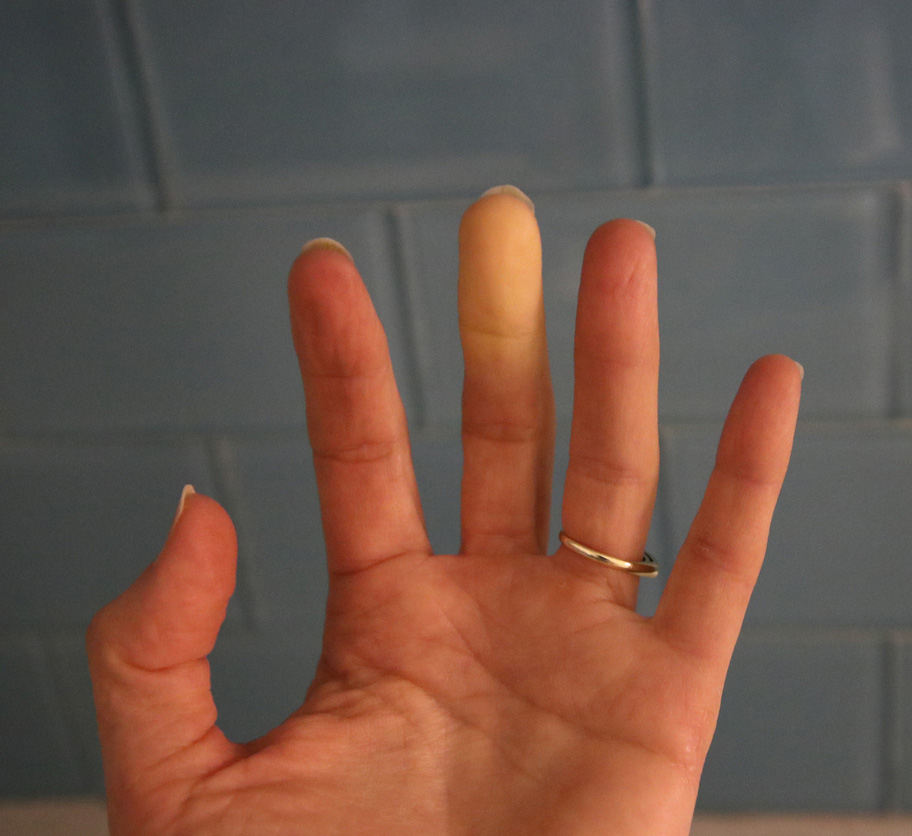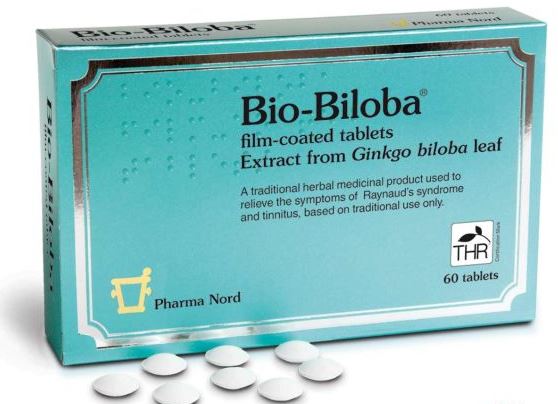It’s as common as hay fever and arthritis, yet 80 per cent of the people who have Raynaud’s Syndrome don’t even realise it. Here’s what you need to know, Olivia Hartland-Robbins reports
Does the colder weather turn your hands a white or blue colour? Do you often lose sensation in your fingers and toes when you’ve been outside for a while?
Cold or discoloured hands may not only be a sign of the weather turning. In fact you may have something more serious.
80 per cent of Raynaud’s sufferers aren’t aware they even have the condition
Raynaud’s Phenomenon, also known as Raynaud’s Syndrome or simply Raynaud’s, is thought to affect one in six people in the UK, which makes it as common a condition as hay fever or arthritis.
There may be as many as 10 million people with the condition in the UK, yet most of us have never even heard of it. What’s more, 80 per cent of Raynaud’s sufferers aren’t aware they even have the condition – but a number of celebrities do.
BBC Breakfast presenter Louise Minchin, Countryfile presenter Ellie Harrison and broadcaster Jenni Falconer all suffer from Raynaud’s Syndrome.
Last year, Jenni shared an image of her painful Raynaud’s-affected fingers on her Instagram (see below).
So, what is Raynaud’s?
When it’s cold, your body will try to conserve heat – so that you don’t freeze.
One way it does this is by slowing down the flow of blood to the farthest points in your body, usually your hands and feet. That’s generally why your toes, fingers and nose are the first things you notice when out and about in chillier weather.
The smaller arteries in your body that carry the blood to those farthest points get narrower (constrict), keeping blood closer to the body’s core to help conserve the heat within. Incidents of constriction are called vasospasms.
For someone who suffers from Raynaud’s Syndrome, those small arteries will overreact and shrink even more than usual – and at a faster rate – often causing them to block. This is what causes your fingers and toes to feel cold or numb and change to a white or blue colour.
This usually lasts around 15 minutes until your body warms back up. Your fingers will then start to feel tingly and will turn red before rewarming and returning to their normal colour.
But it isn’t only the weather that can trigger a Raynaud’s attack. Anxiety, stress, hormone changes and even the use of vibrating tools are among the other triggers for an attack.

For most people Raynaud’s isn’t a serious health problem. However for some, a Raynaud’s attack can be uncomfortable and possibly painful and wearing gloves can make little difference. It can also make everyday tasks, such as buttoning up a coat or unzipping a bag extremely difficult.
People of all ages can suffer from Raynaud’s, but it usually shows up between the ages of 15 and 25. Plus, women are up to nine times more likely to suffer from Raynaud’s Syndrome than men.
There are a number of theories for this. According to a study by researchers at the University of Shizuoka in Japan, the hormone estrogen may be responsible for the development in Raynaud’s in those who have high levels of it.
While the study does not directly demonstrate a causal effect between estrogen and Raynaud’s, it does indicate that estrogen could have a role to play in the development in Raynaud’s in young women.
Moreover, people who use medicines such as those to treat cancer, migraines, or high blood pressure are more likely to suffer from Raynaud’s Syndrome.
Two types of Raynaud’s:
There are two different types of Raynaud’s Syndrome: Primary and Secondary.
Around one in ten people have some form of Raynaud’s, with most of those having the primary form. About one person in 100 (or fewer), will have secondary Raynaud’s.
Primary is the less serious condition that develops by itself, but is mild and manageable. Whilst those who experience secondary Raynaud’s, usually have more severe symptoms.
Secondary Raynaud’s is often caused by an autoimmune condition like scleroderma or lupus. This type will need more investigation and monitoring in case of potential ulceration, sores or gangrene. This happens when cells and tissue in your extremities die from a lack of blood.
Common Raynaud’s symptoms include:
Raynaud’s common symptoms usually affect the fingers and toes, but all extremities can also be affected, including the ears, nose, lips, tongue and nipples. Symptoms may last from a few minutes to a few hours.
- a colour change in the extremities such as hands or feet
- tingling or pain
- cold extremities and numbness
- pins and needles
- difficulty moving the affected area
See a GP if your symptoms are very bad or are getting worse, if it’s affecting your daily life, if you also have joint pain, skin rashes or muscle weakness.
Your doctor will perform a physical exam, take your medical history and have your blood drawn to diagnose whether you have Raynaud’s Syndrome.
They will ask you about your symptoms and may perform a capillaroscopy (a microscopic examination of the nail folds near your fingernails to determine whether you have primary or secondary Raynaud’s).
How to treat Raynaud’s:
To try and help deal with the symptoms of Raynaud’s, the NHS encourages people to keep their home warm and to wear warm clothes when exposed to colder elements.
In general, lifestyle changes such as a healthy diet, frequent exercise, breathing exercises and yoga can play a huge part in the treatment process. Exercise is particularly good for promoting blood circulation and managing stress levels.
Sufferers are also advised to avoid substances that cause your blood vessels to constrict such as caffeine and nicotine products.
Most cases of primary Raynaud’s can be self-treated in the ways mentioned above, although medication is sometimes necessary. Indeed, your doctor may prescribe medication if you have frequent, long-lasting or intense vasospasm episodes.
Exercise is particularly good for promoting blood circulation and managing stress levels
Drugs that help your blood vessels relax and widen include antidepressants, antihypertension (blood pressure) medications and erectile dysfunction drugs.
Some medications may make your condition worse however, as they constrict blood vessels, these include: beta-blockers, estrogen-based drugs, migraine medicines, birth control pills and pseudoephedrine-based (decongestant) cold medicines.
In addition to lifestyle changes and conventional medicines, nutritional supplementation is a more natural approach to help treat Raynaud’s sufferers.
The natural remedy shown to ease symptoms of Raynaud’s
Ginkgo biloba is a traditional herbal extract from the leaves of the ginkgo tree and has been shown to lower the number of Raynaud’s attacks in a number of clinical trials.
The reason for this effect is due to Ginkgo’s ability to support blood circulation to the hands and feet.

In one doubleblind placebo-controlled trial, a two-week assessment period was undertaken during which patients were asked to record frequency, severity and the duration of their Raynaud’s attacks.
Patients were then randomized into two groups, one to receive 120 mg of Ginkgo biloba extract three times a day (total 360 mg per day), and the other a placebo treatment for ten weeks, during which time the same data (frequency, severity and the duration) was to be recorded.
Patients were seen after two and four weeks of treatment and at the end of the ten-week treatment phase.
Results showed that there was a significant effect on the number of attacks compared to those who were taking placebo. The number of attacks per week showed a reduction of 56 percent, whereas placebo reduced by only 27 percent.
Therefore, the study shows that taking Ginkgo biloba may be effective in reducing the number of Raynaud’s attacks in patients suffering from Raynaud’s syndrome.
‘The Ginkgo biloba tree produces characteristic fan-shaped leaves which contain a range of biologically active compounds including ginkgo flavone glycosides and terpene lactones,’ explains Frankie Brogan, senior nutritionist at nutritional supplement maker at Pharma Nord UK.
‘Together, these natural compounds demonstrate a range of benefits to human health, including antioxidant action (protecting cells from environmental pollution) and supporting blood flow to the extremities.

‘These actions allow Ginkgo biloba to help the cardiovascular system as a whole, promoting blood flow by dilating arteries, inhibiting the development of blood clots and protecting cells.
‘As a result, Ginkgo can benefit many conditions brought about by impaired blood flow,’ adds Brogan.
Made to pharmaceutical standards, Bio-Biloba from Pharma Nord, £21.95 (60 tablets) is the only Ginkgo biloba extract available in the UK which has a Traditional Herbal Remedy (THR) licence from medicines watchdog the Medicines and Healthcare products Regulatory Agency (MHRA) specifically for the treatment of Raynaud’s Syndrome.
This means that you can be assured of its quality and safety as a traditional herbal product for use in Raynaud’s, based upon long-standing use as a traditional remedy.
‘While there are a number of Gingko biloba supplements on the market, Bio-Biloba is the only one available in the UK which is produced under pharmaceutical control and which has a THR licence for Raynaud’s,’ Brogan asserts.
‘All of this is a sign of rigorous quality control and reassuring for people looking for a Ginkgo biloba supplement’.
It works fast too. The fascinating images below show the flow of blood through the hands of a person before and then just ten minutes after taking Pharma Nord’s Ginkgo biloba supplement Bio-Biloba.

Without Pharma Nord’s Bio-Biloba: After 10 minutes the skin temperature increases from 12.6° to approx. 20° C
The hands are submerged in 7°C cold water for two minutes and then photographed shortly after. After ten minutes, the hands were photographed again.

After using Pharma Nord’s Bio-Biloba: After 10 minutes the skin temperature increases from approx. 13.8° to approx. 30.9° C.
This amazing thermal imagery shows how Ginkgo biloba extract can help with circulation in a Raynaud’s sufferer.
‘When choosing a Ginkgo biloba supplement, it is important to look carefully at the ingredients,’ says Brogan.
‘For example, a standardized Ginkgo extract ensures that the highly effective active ingredients flavone glycosides and terpene lactones are at a level which, in clinical trials, has demonstrated to be beneficial to health.
‘Non-standardized Ginkgo products are cheaper but also unlikely to compare to the Ginkgo used in most studies. Also, it’s important to secure a Ginkgo biloba extract with a high antioxidant ability for clinical effect.
‘A British study of 18 different Ginkgo biloba preparations found that Pharma Nord Bio-Biloba ensured the highest degree of antioxidant activity.’
As well as a treatment for Raynaud’s, the properties of Ginkgo biloba have also been shown to treat symptoms of other conditions such as tinnitus, since it is thought that poor circulation to the ears may be a cause of the condition.
One of the main proposed benefits of Ginkgo bilboa is that it is able to improve circulation to the brain, improving oxygen and nutrient delivery. Research has also linked Ginkgo biloba to aiding stroke recovery as well as brain health including memory, concentration and age-related decline.
February is Raynauds Awareness Month and the charity SRUK (Scleroderma and Raynauds UK) are carrying out various activities including an online diagnosis tool.
Relevant Healthista Content:
Can echinacea really prevent a cold?
7 signs it’s a common cold and you DON’T need antibiotics
Healthista Content you may also like:
Always got cold hands and feet? Is this the REAL reason you’re always chilly?
